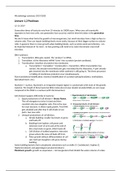Microbiology summary 2019/2020
Lecture 1,2 Poolman
12-11-2019
Generation times of bacteria vary from 10 minutes to 10000 years. When one cell eventually
separates to form two cells, one generation has occurred, and the time this takes is the generation
time.
We don’t know what limits the growth of microorganisms, but small microbes have a high surface to
volume ratio. They can import building blocks more easily, because of their bigger surface to volume
ratio. In general, there is more growth when building blocks, such as amino acids and vitamins, can
be imported instead of ‘de novo’. So fast growing cells tend to be (sub) micrometer size/small
microbes.
DNA-synthesis:
1. Transcription: DNA gets copied. The ‘product’ is mRNA.
2. Translation: at the ribosomes mRNA ‘turns’ into a protein (protein synthesis).
3. Translocation: insertion of proteins into membrane.
a. Transcription + translation + translocation = transertion. When transcription has
started, the already transcribed part gets translated by the ribosomes. A part already
gets inserted into the membrane while synthesis is still going in. The three processes
(+ folding of membrane proteins) occur simultaneously.
Post-translational modification: chemical modification of a protein (phosphorylation, methylation,
lipid attachment, etc.).
Nucleoid nucleus. Nucleoid is an irregularly shaped region in a prokaryote with most of the genetic
material. The length of these bacterial DNA molecules (circular double stranded DNA) are very large
compared to the DNA in a nucleus (with chromosomes).
Cell division happens differently in bacteria:
1. Equal productions of cell division = binary fission.
The cell elongates to twice it sized and then
constricts into two daughter cells. This is the case
for most bacteria. It allows rapid growth. First DNA
gets doubled and after that it will divide in two
parts: two new cells.
2. Unequal productions of cell division.
a. Simple budding: smaller bud starts to grow
and buds off.
b. Budding from hyphae: cell grows and
extension (sort of arm) and at the end of
this a bud starts to grow, which buds off.
c. Cell division of stalked organism: extrusion
grows where the new cell buds off from.
d. Polar growth without differentiation of cell
size: both pre-daughter cells grow during
budding.
Some budding bacteria form cytoplasmic extensions such as stalks (3. Caulabacter), hyphae (2.
Hyphomicrobium) and appendages (ancalomicrobium).
Planktonic growth: growth as suspension microorganisms that inhabit the water column of a lake.
, Sessile growth: microorganisms grow attached to a surface. These attached cells can develop into
biofilms (=an attached polysaccharide matrix containing embedded bacterial cells). Some biofilms
form multi-layered sheets with different organisms present in the individual layers. These biofilms
are called microbial mats.
Exponential growth: repetitive pattern, where the number of cells doubles in a constant time
interval. The relationship between the initial number of cells in a culture and the number present
after a period of exponential growth: N = N0 ∙ 2n
So this is 2, because ones the cell divides it becomes two cells, to the power of the amount of cells
that have doubled (n) multiplied by the number of cells at the beginning. When you have one cell,
this means n = 0. After it has doubled n = 1. 2 0 21, when these two cells double, you will get four
cells. 21 22.
N = the final number of cells.
N0 = the initial number of cells.
t
n = number of generations during the period of exponential growth. n = N = N0 ∙ 2t/g
g
t
g= (=generation time = doubling time td). t = duration of exponential growth in days, hours or
n
minutes. N is the number of generations during the period of exponential growth.
N = N0 ∙ e.t
ln 2
lnNt – lnN0 = ∙ t = = (specific) growth rate (h-1)
td
doubling number of cells: lnNt : N0 = ln2
Note: in the book ‘k’ is used for the growth rate .
When you plot the number of cells (with exponential growth), you will get a curve with a
continuously increased function of time. This is an arithmetic plot. When you plot this on a
logarithmic scale, you will get a straight line. From this straight line, n can be calculated. The slope of
the line is equal to log (N)/t.
Look at page 177 for questions/examples.
Batch culture: an organism grows in an enclosed vessel (closed-system of fixed volume). These
organisms cannot grow exponentially for several reasons. Instead of a microbial growth cycle
(exponential) it has an growth curve. The growth curve has four phases: lag, exponential, stationary
and death.
Lag phase: growth begins.
Exponential phase: when a growing cell population doubles at regular intervals.
Stationary phase: when exponential growth ceases, because (1) an essential nutrient in the culture
medium is depleted and/or (2)) the organism’s waste product accumulate. In this phase there is no
increase or decrease.
Death phase: no new cells and the ones present start to die.
Viable count = measures the cells in the culture that are capable of reproducing.
Optical density (turbidity) = a quantitative measure of light scattering by a liquid culture. When the
cell number increases, the turbidity also increases.





